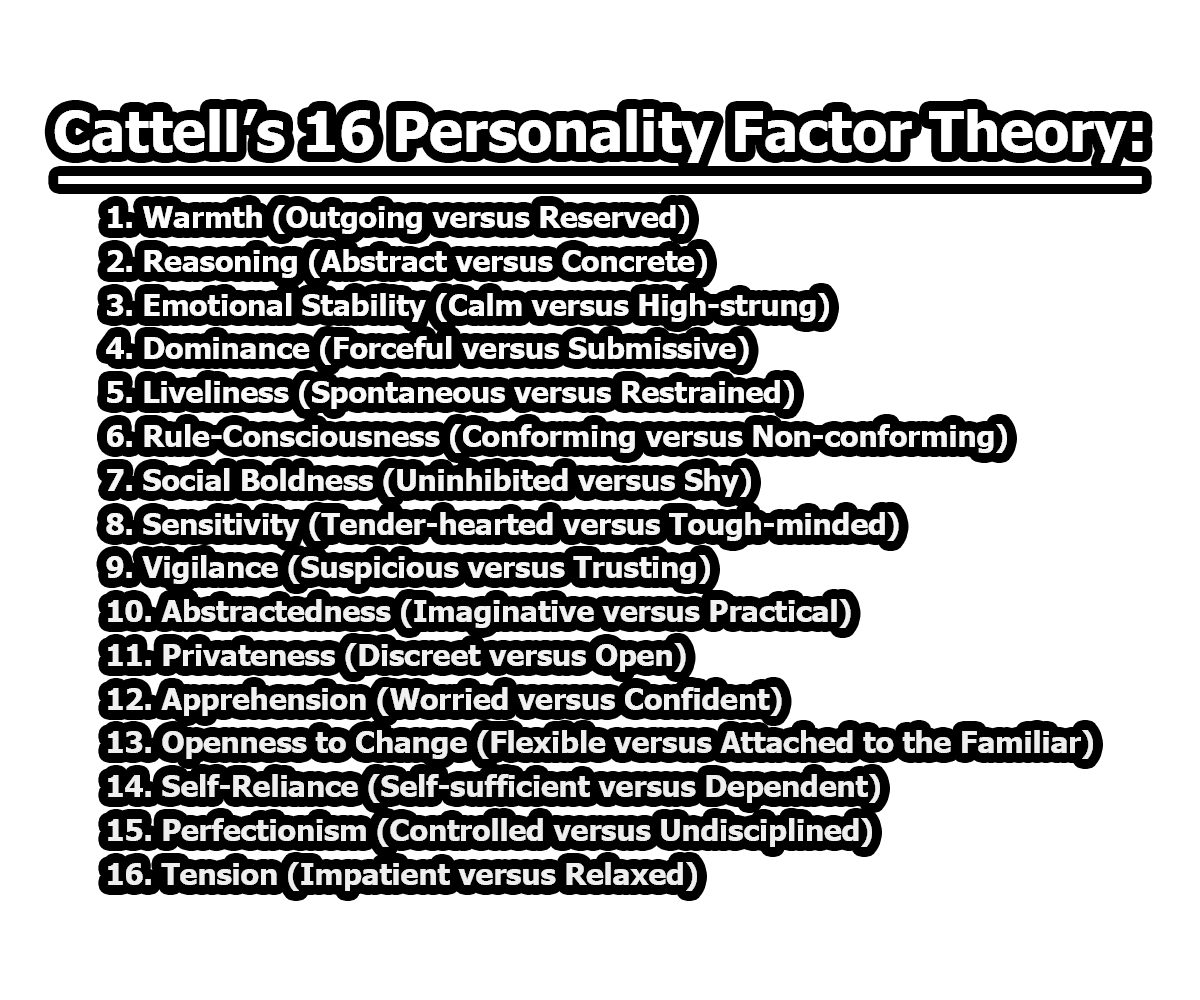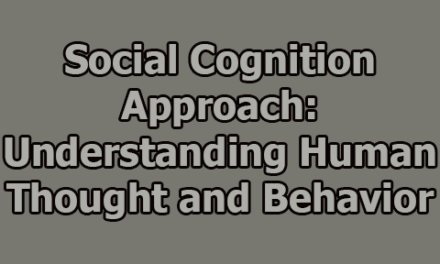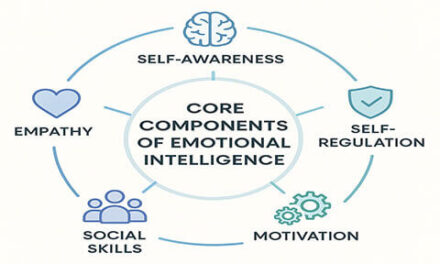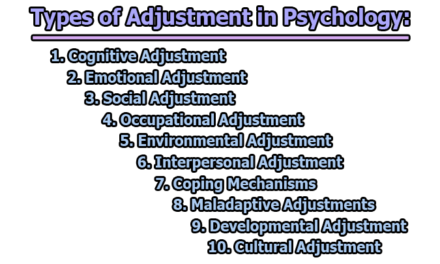Cattell’s 16 Personality Factor Theory:
Personality psychology, as a branch of psychology, has long sought to understand and categorize the vast intricacies of human behavior. One of the most significant contributions to this field comes from Raymond Cattell, whose 16 Personality Factor (16PF) theory provides a detailed framework for understanding the nuances of human personality. Below is a detailed exploration of the Cattell’s 16 personality factor theory:
1. Warmth (Outgoing versus Reserved): This trait reflects an individual’s sociability and affection toward others. Outgoing individuals are friendly, approachable, and enjoy engaging with people, whereas reserved individuals prefer solitude and exhibit more reticent behaviors.
Example: An outgoing person might organize social gatherings and actively participate in conversations, while a reserved person might opt to stay home with a book or observe quietly during social events.
2. Reasoning (Abstract versus Concrete): This dimension measures cognitive ability and problem-solving style. Abstract thinkers excel in logic and theoretical understanding, while concrete thinkers focus on practical, hands-on solutions.
Example: An abstract thinker might excel in designing innovative algorithms, while a concrete thinker might focus on debugging and optimizing existing code.
3. Emotional Stability (Calm versus High-strung): Emotional stability indicates how well an individual copes with stress. Calm individuals maintain composure under pressure, while high-strung individuals are more reactive and prone to anxiety.
Example: In a crisis, a calm person might methodically plan a response, while a high-strung person may panic and struggle to focus.
4. Dominance (Forceful versus Submissive): This factor gauges assertiveness and control. Forceful individuals take charge and assert authority, whereas submissive individuals prefer to follow and accommodate others.
Example: In a team meeting, a forceful individual might lead the discussion and push for their ideas, while a submissive person might agree with others and avoid confrontation.
5. Liveliness (Spontaneous versus Restrained): Liveliness reflects enthusiasm and energy. Spontaneous individuals are playful and energetic, while restrained individuals are more serious and deliberate.
Example: A lively person might impulsively suggest an impromptu trip, while a restrained person would prefer to plan meticulously before taking any action.
6. Rule-Consciousness (Conforming versus Non-conforming): This trait assesses adherence to rules and standards. Conforming individuals value tradition and discipline, while non-conforming individuals challenge norms and prioritize independence.
Example: A conforming person might strictly follow a company’s protocol, while a non-conforming person might propose a creative but unconventional approach.
7. Social Boldness (Uninhibited versus Shy): Social boldness measures confidence in social settings. Uninhibited individuals are fearless and outgoing, while shy individuals are reserved and cautious.
Example: An uninhibited person might volunteer to present in front of a large audience, while a shy person might avoid public speaking altogether.
8. Sensitivity (Tender-hearted versus Tough-minded): Sensitivity gauges empathy and compassion. Tender-hearted individuals are nurturing and empathetic, while tough-minded individuals are pragmatic and unsentimental.
Example: A tender-hearted nurse might spend extra time comforting a patient, while a tough-minded nurse focuses on efficiency in treatment.
9. Vigilance (Suspicious versus Trusting): Vigilance indicates the degree of trust in others. Suspicious individuals question motives and remain cautious, while trusting individuals are open and accepting.
Example: A suspicious person might scrutinize a colleague’s intentions when receiving help, whereas a trusting person readily accepts the gesture at face value.
10. Abstractedness (Imaginative versus Practical): Abstractedness highlights creativity and imagination. Imaginative individuals enjoy exploring new ideas, whereas practical individuals focus on realistic and tangible solutions.
Example: An imaginative person might envision futuristic solutions, while a practical person devises immediate, applicable strategies.
11. Privateness (Discreet versus Open): This factor reflects self-disclosure tendencies. Discreet individuals are reserved about their thoughts and feelings, while open individuals are candid and transparent.
Example: A discreet individual might keep personal challenges to themselves, while an open individual shares their struggles openly with friends.
12. Apprehension (Worried versus Confident): Apprehension measures self-assurance. Worried individuals are prone to self-doubt and anxiety, while confident individuals are self-assured and optimistic.
Example: A worried student might constantly second-guess their answers on an exam, while a confident student trusts their preparation.
13. Openness to Change (Flexible versus Attached to the Familiar): This trait evaluates adaptability. Flexible individuals embrace novelty and innovation, while those attached to the familiar prefer routine and stability.
Example: A flexible employee readily adapts to a new software system, while one attached to the familiar resists the change.
14. Self-Reliance (Self-sufficient versus Dependent): Self-reliance measures independence. Self-sufficient individuals prefer autonomy, while dependent individuals thrive in collaborative environments.
Example: A self-reliant entrepreneur confidently starts a solo venture, while a dependent individual prefers working within a team.
15. Perfectionism (Controlled versus Undisciplined): Perfectionism assesses organizational skills and discipline. Controlled individuals are meticulous and structured, while undisciplined individuals are spontaneous and less detail-oriented.
Example: A controlled individual maintains a detailed planner, while an undisciplined person prefers an unstructured daily routine.
16. Tension (Impatient versus Relaxed): Tension gauges stress levels and urgency. Impatient individuals are high-strung and driven, while relaxed individuals are calm and composed.
Example: An impatient driver honks frequently in traffic, while a relaxed driver listens to music and waits patiently.
Uses for Cattell’s 16 Personality Factors Test (16PF):
The 16PF has a variety of applications, including:
- Career Development: Helps individuals understand their strengths and preferences, guiding career choices.
- Human Resources: Assists in employee selection, team building, and leadership development.
- Personality Assessment: Offers a detailed evaluation of personality traits for self-awareness and growth.
- Research: Provides a standardized tool for studying personality in various contexts.
Additionally, psychologists utilize the 16PF to address patients’ needs and design therapy plans by assessing anxiety, adjustment issues, and behavioral challenges.
Cattell believed that personality was not an unknowable mystery. Instead, he proposed it could be systematically studied, organized, and sometimes predicted based on underlying traits.
It is apparent that Cattell’s 16 Personality Factors provide a robust framework for understanding individual differences. By assessing where a person falls on each of these dimensions, psychologists, educators, and employers can gain valuable insights into their personality and behavior. This nuanced approach allows for more personalized interventions, whether in clinical settings, educational environments, or workplace contexts. The 16PF continues to be a cornerstone in the study of personality, highlighting the complexity and richness of human behavior.
References:
- Cattell, R. B. (1965). The scientific analysis of personality. Baltimore, MD: Penguin Books.
- Cattell, R. B. (1979). Personality and learning theory: The structure of personality in its environment. New York, NY: Springer Publishing.
- Fehriinger, J. (2004). The 16 Personality Factor Questionnaire (16PF). https://www.similarminds.com
- Karson, S., & O’Dell, J. W. (1976). A guide to the Clinical Use of the 16PF. Champaign, IL: IPAT.
- Mischel, W. (1986). Introduction to Personality. New York, NY: Holt, Rinehart & Winston.
- (n.d.). 16PF Comprehensive Insights Report. https://www.psionline.com

Library Lecturer at Nurul Amin Degree College










